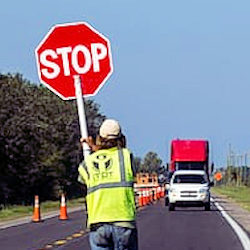Roadway Best Practices
- Flagging should be used only when all other methods of traffic control are inadequate to direct, or control, traffic.
- A TCP showing flagger locations, signs and devices is required for any flagging operation no matter the duration.
- Minimum standard flagging paddle size allowed is 18 inches. It is recommended that a 24-inch paddle be used to improve visibility.
- In a mobile operation when the flagger is moving with the operation, all signs associated with the flagger must be moved ahead whenever work advances to more than 2 miles from the first advance warning signs.
- A "Flagger Ahead" sign must be within 1,500 feet of the flagger and the flagger station must be able to be seen from the sign. If terrain does not allow a motorist to see the flagger from the "Flagger Ahead" sign, the distance between the sign and the flagger must be shortened to allow visual contact. The spacing must not be less than the required distance based on the highway speed.
- During hours of darkness, flagger stations must be illuminated by using a portable light plant or balloon type lights. The flagger should be visible and discernible as a flagger from a distance of 1,000 feet.
- Pilot car use is appropriate for long work areas to help maintain traffic speeds and to guide traffic through the work areas. Pilot car operators must be certified flaggers able to trade off duties with other flaggers.
- When flagging at intersections, a recommended best practice is to reduce traffic approaching the intersection to a single lane whenever possible. This may require lane closures and restricting access to turn pockets with channelization devices. If signalized, the signal must be either turned off or set to all red "flash" mode. At no time will traffic be flagged with an active signal in full operation.
- The placement of a flagger at the center of an intersection to control traffic is not allowed. The only person allowed to legally control traffic from the center of an intersection is a uniformed police officer. No matter who is performing the intersection flagging, the appropriate advance warning signing is required to be in place.
- A four-sign sequence should be used for all flagging on roadways with posted speeds of 45 mph or higher. The "one lane road ahead" sign may need to be replaced with a more appropriate sign if flaggers are used for short traffic stops for truck crossing, tree falling, or other work and traffic will not be alternated in a single lane.
Knowledge Check Choose the best answer for the question.
1-6. For what duration must a traffic control plan that includes flagger locations, signs, and devices be implemented for a work zone?
You forgot to answer the question!


